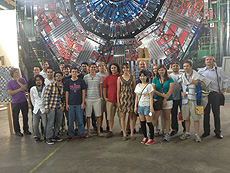U.S. institutions collaborate on new CMS pixel detector
 |
| These U.S. students work on the CMS pixel detector. They hail from various institutions, including Kansas State University, Purdue University, University of Illinois at Chicago, University of Kansas, University of Nebraska - Lincoln and University of Puerto Rico at Mayaguez. Here they stand in front of the poster of the CMS detector at CERN in July. |
At the heart of the four-and-a-half-story-high particle detector of the CMS experiment at CERN is a collection of millions of tiny silicon devices known collectively as the pixel detector. When the LHC restarts after a planned shutdown from the end of 2016 to the middle of 2017, it will feature a brand-new pixel detector designed and built by a team at Fermilab in collaboration with 19 U.S. universities and more abroad.
The new detector is part of an upgrade plan that, after a successful review at the end of August, is slated to receive the Department of Energy's second stage of approval. Known as Critical Decision-1, the review covered the overall scale of the cost and schedule of the construction.
The pixel detector is the particle detection system closest to the collision point. It measures the position of particles as they make their way through the detector with a precision better than one-tenth the size of a human hair . This helps scientists distinguish bottom quarks—which are produced, for example, in the decay of a Higgs boson—from other types of quarks.
"The pixel detector contributes significantly to the precision with which you extrapolate the tracks back to the collision point," said Marco Verzocchi, a scientist at Fermilab who is on the project's management team. "This helps you to identify the tracks that did not come from the collision point."
The new pixel detector design ensures that the detector functions well when the upgraded LHC produces a much higher rate of proton-proton collisions. Its support structure will be built out of carbon fiber, a much lighter, less dense material than the current pixel detector's aluminum. This means particles are less likely to hit one of the atoms that make up the detector, thus helping reduce the number of extraneous particles generated when particles coming from a collision do hit atoms in the detector material.
The CMS team also must update the readout electronics to cope with the higher collision and data rates that will arise from a more intense beam.
"The main reason for improving and replacing the pixel detector is to address the problem with the data rates," Verzocchi said. "We're going to profit from the lessons we learned in building the first detector."
In addition to building the support structure and some of the electronics for the system, Fermilab will provide the cleanroom facility where the detector ultimately will be assembled.
Cecilia Gerber, a professor at the University of Illinois at Chicago and a manager on the project, is heading a team of graduate students and postdocs from her university that is preparing to test the detector modules during construction.
"The opportunity to work on a hardware project of this magnitude doesn't come around too often," Gerber said. "You really stretch the technology when you build these devices, as you're mostly not dealing with off-the-shelf parts. Involving young people in this process, allowing them to to see what it takes to actually build these detectors—I think that it really broadens their horizons."
—Laura Dattaro
|